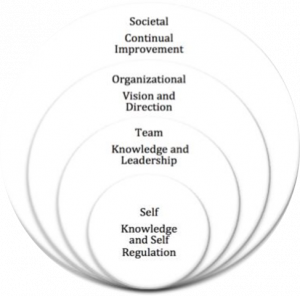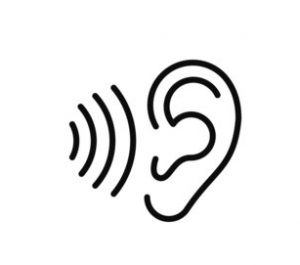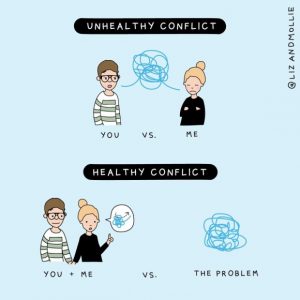2 Workshop 2: Team Dynamics & Conflict Resolution
Sania Azim; John Donald; and Technical Editor: Yasamin Jahani Kia

LEARNING OBJECTIVES
This workshop will advance from Domain 1 to Domain 2 which is team leadership in engineering settings.
Following this workshop, students will be able to:
- Increase team’s productivity and drive by building positive team dynamic.
- Develop and demonstrate active leadership through soft skills.
- Strategize problem-solving by identifying the causes of conflicts.

This workshop will be split into three main parts:
- Defining team dynamics and conflict resolution.
- Skills for conflict resolution.
- Conflict resolution.
TEAM DYNAMICS & CONFLICT RESOLUTION
![]()
As we know, every team has to collaborate to achieve goals and resolve challenges, and we have seen this in our own engineering design projects year after year, but what is the secret recipe to effective collaboration?
The answer is having a positive team dynamic. Your team’s dynamic describes the behavioral relationships between the members of your group. This includes things like how they interact, communicate, and cooperate with one another. Having a positive team dynamic influences your teams ability to accomplish goals. It also aids in developing a shared vision and embracing conflicts, which is why it is important to spend some time building that at the beginning of any project.
Team Conflict is defined as a difference in attitudes, thought processes, and understanding between individuals in a team. When you first think of the word conflict you probably think of something negative. However, conflicts can also be beneficial for your team. You just need to be able to direct the conversation in a healthy direction.
A healthy conflict, on the other hand, is always constructive in nature, meaning that it will always benefit the team. To resolve any conflict, you need to be aware of the causes of conflicts and have the right leadership skills, such as active listening skills, which we will be building on very soon.
This picture perfectly summarizes the differences between an unhealthy and healthy conflict. In a healthy conflict, you work together to tackle the problem and find ways to get around it.
Conflicts are an unavoidable part of any team but they do not always have to be negative. We do not want to avoid conflicts, we want to embrace them and turn them into something constructive and positive.
![]() Self-reflect on any past experiences where your team had a conflict due to disagreements. Was the end result always negative or did those conversations eventually benefit the team in the end?
Self-reflect on any past experiences where your team had a conflict due to disagreements. Was the end result always negative or did those conversations eventually benefit the team in the end?
1. Osborne, B. (May, 2020). “What are team Dynamics and Why are They Important?”. Rally Bright. Retrieved from https://www.rallybright.com/understanding-team-dynamics.
2. Juneja, P. (2015). “Understanding Conflict – Meaning and Phases of Conflict”. MSG. Retrieved from https://www.managementstudyguide.com/understanding-conflict.htm
ACTIVE LISTENING 
Leadership is not a single skill, rather it is a combination of soft skills such as empathy, insight, and communication skills. Therefore, anything that can be used to effectively lead and manage people. Active listening is one of those many skills that cone under the broad umbrella of leadership skills and is used to encourage better communication within the group. Actively listening means showing that you are attentive, receptive, and respectful.
In total there are three levels of listening which we will be going through in detail.
Terrel, S. (November, 2008). “What is Interpersonal Intelligence and How to Develop It?”. Mind Valley. Retrieved from https://blog.mindvalley.com/interpersonal-intelligence/
THE 3 LEVELS OF LISTENING
Level 1 – Internal Listening
Level 1 is when you listen in order to speak. This happens when someone is speaking to you and in your head, you are mostly thinking about the next thing you are going to say in response. It also means you are focusing on your own thoughts, feelings, and opinions. This level comes naturally to us and it is where most people are. However, we want to build up from here in order to be better listeners.
In order to figure out which level you are at, we have listed some key identifiers for each level of active listening.
The key identifiers for Level 1 are:
- You are focused on self – mostly thinking about what you are going to say next instead of trying to understand the feelings of the other person.
- Interrupting the speaker mid-sentence. For instance, instead of waiting for the cue to speak, you interrupt the person and speak your mind.
- Lastly, you pass opinionated input without regard for the feelings of the other person.
Level 2 – Focused (Active)
Level 2 is when we start to get into active listening. It also means that you are listening in order to hear. What this means is that it requires that you listen intently to another person and fully focus on what the other person is saying to you before thinking about your own judgment and opinions. This level also teaches you how to silence your inner voice so that it is not clouding your judgement and your conflict resolution approach unintentionally.
The key identifiers for Level 2 are:
- You are focused on the speaker rather than self.
- You use attentive and open body language and non-verbal cues to show you are listening. Some non-verbal cues would be, nodding your head to show you agree with them, or turning your body towards them when they speak to you to show they have your full undivided attention.
- There is minimum to no interruptions – you simply wait for the cue to speak before giving a response or asking questions.
Level 3 – Interactive (Fully active)
Level 3 means you are not just listening to respond or hear, but you are also listening to understand. This is considered to be the highest level of active listening and where we ideally want to be when we are communicating. It means to listen with authenticity, meaning that we are listening because we are curious and we care, not because we have to. Lastly, it also means to consider context and therefore, do not just interpret their words but also their body language and expressions.
The key identifiers for Level 3 are:
- Restating or paraphrasing the speaker’s point to verify that what you understood was correct. For instance saying something along the lines of “What you are trying to say is ….” is an effective way to verify.
- Acknowledge the other person’s feelings with non-verbal communication such as mirroring their expressions or using short verbal cues such as I understand, or I agree.
- Giving responses and asking open ended follow up questions to show that you understand how the other person feels without interruptions and in a respectful manner.
Russel, M. (November, 2017). “Strategic Leadership: The 3 Levels of Listening”. Start It Up. Retrieved from https://medium.com/swlh/strategic-leadership-the-3-levels-of-listening-e3f0c27f8d01
ACTIVITY 1: ACTIVE LISTENING
The worksheet version for activity 1 can be found here.
Active listening means treating listening as an active process, rather than a passive one. Active listeners show they are listening, encourage sharing, and strive to understand the speaker.
Before watching the interactions, go through the table of non-verbal and verbal cues so that you know what to look for in the videos.
|
Non verbal Cues
|
Inviting the conversation
|
Discouraging the conversation
|
| Verbal Cues |
|
|
Adapted from Frances Westley, Co-Founder of the Waterloo Institute for Social Innovation and Resilience, University of Waterloo.
Interaction 1:
Interaction 2:
REFLECTION
- Summarize the main points made by the speaker (what were they trying to get across). Include how the points were presented such as emotional content (e.g., tone, verbal, non-verbal and body language).
- What did Listener 1 do well? What could they improve on to make the speaker feel more comfortable?
- What did Listener 2 do well? What could they improve on to make the speaker feel more comfortable?
- What level of active listening is each listener at? What is your reasoning?
- Reflect: How do you feel when you are being actively listened to?
ACTIVITY 1: KEY TAKEAWAYS
Hopefully by now you are able to tell the difference between the 3 levels. Active Listening is a skill we all possess naturally. Everyone starts at Level 1 but Level 3 is where we ideally want to be. This requires practice and self-discipline. Building up to level 3 is important because in order to become active engineering leaders, we should care about the performance of the entire team, not just our own and for that we need to be good listeners.
IDENTIFYING & RESPONDING TO CONFLICTS
Any conflict you have ever been in can be grouped into one of these 3 major types of conflicts:
- Task conflict: a conflict that occurs because of WHAT – related to the actual work that gets done.
- Relationship conflict: a conflict that occurs because of WHO – related to any interpersonal tension within the team.
- Process conflict: a conflict that occurs because of the HOW – related to how the work gets done.
Sometimes you can even have a mix of two or more different conflict types. It all depends on your situation.
- TASK CONFLICT
Task Conflict is a conflict around a particular task. This can appear as:
- Disagreements over the goal or objective of the task – usually due to lack of alignment on a project’s desired outcome.
- Contents of decisions made in a team. For example: you are working in a team, and the task is figuring out what material to use for your project. One person might say use 3D printed parts while the other might say use Meccano pieces to build the project. Due to the disagreements, a conflict occurs.
- Different interpretations of facts surrounding the task, this leads to people performing tasks differently which creates a conflict.
Any conflict around what needs to be done is know as a task conflict.
2. RELATIONSHIP CONFLICT
The second type of conflict is a relationship conflict which is a conflict around relationships with other team members involving:
- Different attitudes such as discrimination due to seniority, meaning somebody who is senior is getting treated differently than others simply because they have been in the company longer.
- Different beliefs and biases – if someone’s strong belief on a particular social issue or religion is affecting the team or project at work, it becomes a relationship conflict.
- An absence of a shared vision – this ties the importance of taking the time at the beginning of the project to build a positive team dynamic. You would experience less of this kind of conflict if you take your time to do so.
This conflict is around:
- Delegation and logistics of task completion – who will do what, time allotted for each task, and setting deadlines.
- Responsibilities: who gets the final say, who has the authority to make the final call, and who is in charge.
- Strategies – what approach of strategies should be taken to best handle a task.
Any conflicts that revolve around these aspects of a project are called process conflicts.
The 4 step resolution process works for any of the 3 conflicts listed above.
STEP 1 – We are aware that there is a conflict, now we need to actively listen in order to identify the type of conflict. Is it a task conflict, relationship conflict, or a process conflict? Once you know the type of conflict, you will be able to identify the root cause of the problem much easier.
STEP 2 – Discuss, acknowledge, and manage emotions of self and team as an impact of conflict. This is when you discuss with the team how they feel about the conflict. For instance, is it something that needs to be addressed now or can it wait until the end of the project? Or is it affecting the project and their performance?
STEP 3 – Individually get each views of each party directly involved on how to resolve the conflict.
STEP 4 – Once you have a list of solutions from both sides, the next step is to identify solutions that both parties support and to agree on a final action to take.
Adapted from Tiefenbacher, W. (2017). “Team Conflict: Understanding the types of conflicts and how to manage them sustainably”. CQ Net. Retrieved from https://www.ckju.net/en/dossier/team-conflict-understanding-types-conflict-and-how-manage-them-sustainably
RESOLUTION STRATEGIES
A lot of the times, there is no perfect solution that all people agree on. In those cases, you have to resort to using one of these 3 resolution strategies.
COLLABORATION – Both parties win without having to give up anything. This is considered as the best case scenario. The only drawback is that it takes time and effort to discuss and come to an agreement that works in favor of both parties.
COMPROMISE – Adapted when there is limited time and a decision needs to be made quickly. By compromising, both parties win but they also have to give up something. This means that you might not be choosing the top solution in the list of various solutions but you compromise and settle for a solution that partially satisfies both parties.
ACCOMMODATING – One party gives the win to the other in this scenario. This happens in situations where when neither parties can decide on a single solution. For the sake of the project and team, one party backs out and yields the win to the other party. This usually happens in cases where one party is more passionate about the matter than the other.
Retrieved from https://www.engineering.com/story/resolving-conflict-in-your-engineering-career
ACTIVITY 2: CASE STUDIES
The worksheet for activity 2 can be found here.
In this activity, you will read and reflect on a case study of your choice. Then you will identify the type of conflict they are facing and create a 4 step resolution process.
CASE 1:
Party A – Ben: Ben and Priya have worked together for 3 years. Ben is a mentor to Priya and feels obligated to provide her with all the resources she needs for her projects/tasks. He feels Priya is not very thankful of him. Priya tells Ben she finds him intimidating. Ben feels insulted and leaves her to work and figure things out on her own.
Party B – Priya: Priya feels she is not being heard as a woman. She is unable to find her voice in the workplace. Priya tried to subtly convey her dislike of Ben’s interference in her work numerous times but failed to get an appropriate response. Recently, Ben talked to her in a condescending tone which upset Priya.
Now,
Step into the observer mindset: They both come individually to the observer to ask for support.
What do you do in a situation where one person is feeling invalidated while the other feels disrespected by the other’s actions/words?
CASE 2:
Party A – Eli: Eli was recently hired at an engineering firm. Eli is a transgender employee who prefers to be identified using she/her pronouns. She gets in touch with the HR department to complain about her manager Harry, who she believes intentionally refuses to call her by her chosen name and declines to refer to her with accurate gender-related pronouns, despite her correcting him several times. She wants HR to set up an ethics and pronouns workshop for employees.
Party B – Harry: Harry is Eli’s senior manager and has just been exposed to pronouns. Harry has a strong religious belief that a person’s gender can’t be changed which causes him to have an implicit bias. Due to his implicit bias and discomfort, he occasionally calls her using incorrect pronouns, which he does not realize until much later. One day, Eli corrects him mid-sentence which angers him, and he overreacts by standing his ground and claiming his right to free speech and free exercise of religion.
Now,
Step into the observer mindset: As their employer/HR, what do you do when faced with competing expectations of respecting an employee’s gender identity and honoring an objecting employee’s religious convictions?
CASE 3:
Party A – Matt: Ahmed has been paired with Matt and a group of Matt’s close friends by their TA for a design project in class. Matt is very outgoing and immediately takes charge of delegating tasks and responsibilities. Since Matt knows his friend’s strengths and weaknesses, he deliberately assigns them simpler tasks that can easily be completed before the deadline. He leaves all other tasks for Ahmed. The team was able to submit all work before the deadline and Matt credits this to his leadership skills. He is later contacted by the TA due to Ahmed’s complaint about his attitude.
Party B – Ahmed: Ahmed is a transfer student and has been paired with Matt and Matt’s close friends. He feels he is assigned all difficult and time-consuming tasks and did not have a choice. He feels like he is being treated unfairly and contacts Matt weeks into the project for reassignment of tasks which Matt politely refuses due to not having enough time. Ahmed manages to finish his share of work on time by spending majority of his study time on this project. He then expresses his concerns to the TA about his mistreatment in the group.
Now,
Step into the observer mindset: As their TA/ team member, what action or advice would you give each student in handling the conflict?
CASE 4:
Party A – Lee: Lee and Jim have been working together in a small business for a year. Lee is a prized employee for their firm since he has been able to bring in a lot of money for the business. Lee is a part of the design and marketing department. For the company’s latest product, Lee proposes the use of a material that is reasonably durable and saves the company money. Jim opposes his proposition as he thinks a weaker product could hurt the company’s reputation. Lee trusts his own judgment and believes the product will be durable and bring in profit.
Party B – Jim: Due to working for a small business, Jim has had to opportunity to work in HR and customer service, alongside design. He wants to propose the use of a material that is highly durable for making the product and will guarantee positive customer reviews. The only downside is that it will be more expensive and affect their profits. He does not agree with Lee and how he handles tasks.
Now,
Step into the observer mindset: What will you do as a member or CEO of the firm to resolve this issue between members with conflicting ways of handling tasks?
Keep in mind small businesses have limited resources, restrictive budget, and modest earnings.
4 STEP RESOLUTION PROCESS:
Step 1: Actively listen to identify cause and type of conflict.
What is causing the conflict? Which type of conflict are we going through?
Step 2: Discuss, acknowledge, and manage emotions of self and group as an impact of conflict.
Do we need to discuss and resolve this conflict NOW? Why? Is it hindering the ability to perform as a team and get the project finished on time?
Step 3: Get each party’s view on how to resolve conflict.
How does Disputant A think this can be resolved? How does Disputant B think it can be resolved? Consider making a list of possible solutions.
Step 4: Identify solutions all parties support and agree on a final action.
Can you identify and pick out any solutions that all disputants support and then agree on a final action?
This specific strategy is called collaborating where both parties win, because their best solutions align.
What if there is no such solution that all support? Use one of the other strategies.
REFLECTION
Here are some questions to consider after you have completed the second activity:
- What strategy of conflict resolution do you use most in daily conflicts?
- How are you using active listening skills and interpersonal intelligence in your day-to-day life?
ACTIVITY 2: KEY TAKEAWAYS
We can now observe that conflicts can be resolved by identifying and using different resolution strategies. You can practice leadership by learning to mediate conflicts instead of avoiding them altogether. The catch here is that we want to embrace conflicts not avoid them. Learning to respond to conflicts is critical to engineering as it builds emotional intelligence and increases productivity in teams.
WORKSHOP KEY TAKEAWAYS
There are some key takeaways that we wanted to highlight.
- Take initiative as a leader to unite team as conflicts occur naturally throughout the project – understand that conflicts are unavoidable and allow a space for discussions to happen. The catch here is to remember to embrace conflicts, not avoid them.
- Actively listening in the context of the speaker’s surroundings and emotions is important in order to become better listeners. By being better listeners, you are being a better leader, engineer, and overall a better person.
- A leader must develop and guide the full potential of their team through disagreements in an engineering context – so learn to identify conflicts and act before healthy team disagreements turn into something that is destructive for your team.
RESOURCES
Click here to access the workshop worksheets.


